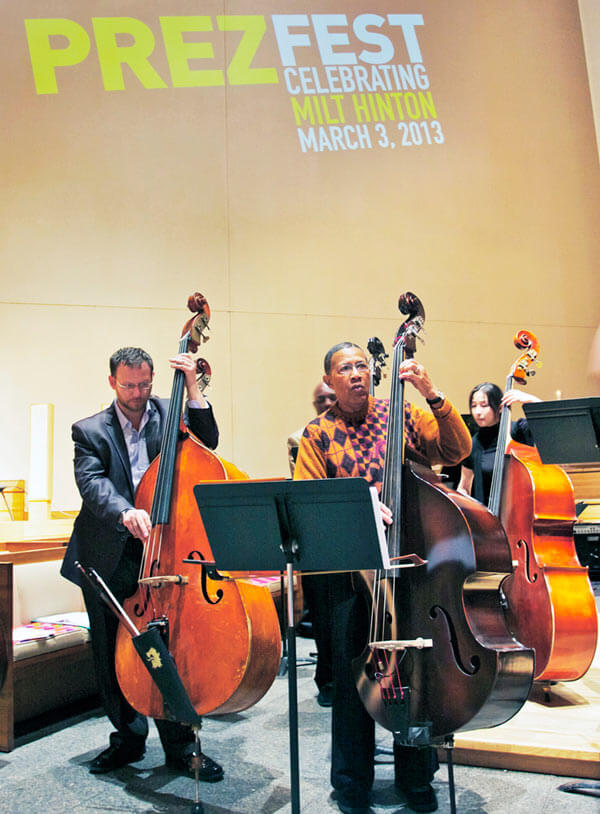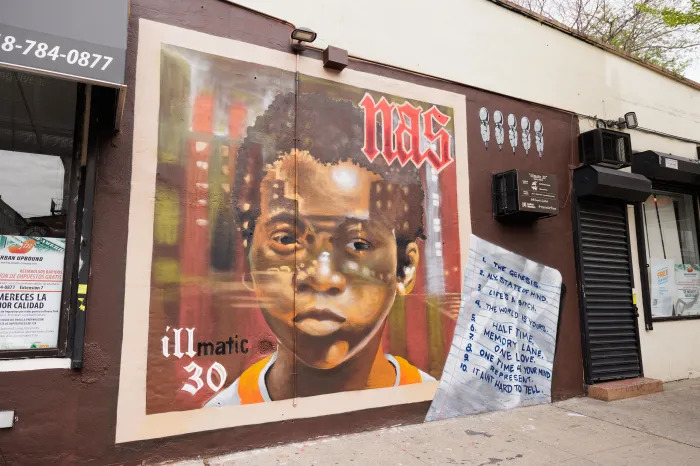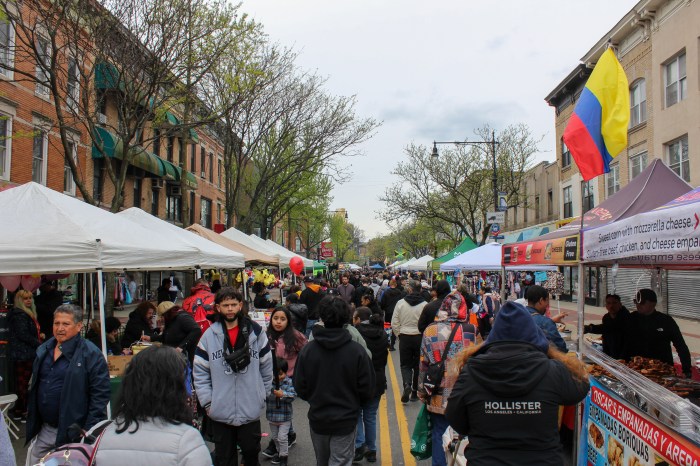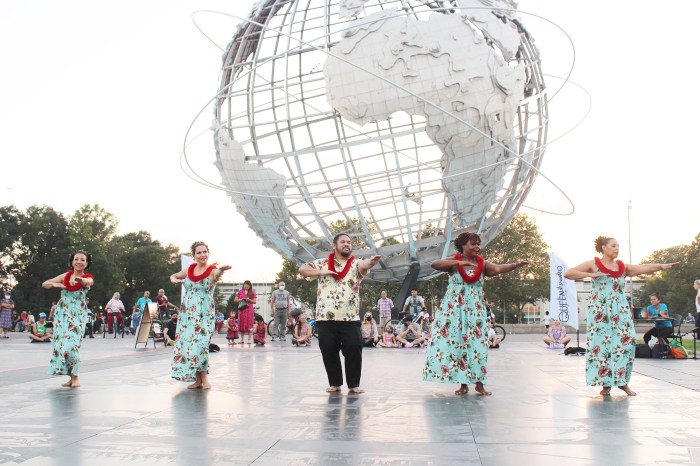By Norm Harris
The Jazz Committee/Midtown Arts Common in the Manhattan Saint Peter’s Church, “The Jazz Church,” continued its annual Prez Fest Celebration last week by honoring the historic contributions of the late and iconic former St. Albans, Addisleigh Park resident Milt “The Judge Hinton,” a jazz bassist, educator, jazz photographer and NEA jazz master.
The Prez Fest 2013 Planning Committee of Lynne Mueller, Connie Peterson, Andrew Rowan, Ike Sturm, David Berger and Holly Maxson with support from the Fund For Creative Communities via The New York State Council on the Arts and many volunteers too numerous to mention made this year’s busting-at-the-seams celebration March 3 one of the most musically and ethnically inclusive and memorable events for the history books.
The Lutheran church at 54th Street and Lexington Avenue highlights the works of late jazz artists to keep their contributions alive in the program known as Prez Fest.
The Milt Hinton Legacy (1910 – 2000) was remembered in royal style in the church’s living room, photo gallery and later in the main sanctuary and performance space. With a capacity attendance, the celebration began with a viewing of the historically fascinating and highly regarded documentary film “Keeping Time: The Life, Music and Photographs of Milt Hinton.” It was followed by a panel discussion moderated by the 2002 film Co-producer, Co-writer and Co-director David G. Berger with bassists Bill Crow and Rufus Reid, Rutgers University Institute of Jazz Studies historian, Dan Morgenstern and National Endowment for the Arts Jazz Master and Hinton contemporary, trumpeter Joe Wilder.
Holly Maxson, who co-produced, co-wrote and co-directed the documentary film with Berger and Kate Herson, pointed out that on the wall of the church living room adjacent to the panel discussion area were 30 framed and matted black and white candid photos of many of Hinton’s musical colleagues such as Cab Calloway, Charles Mingus, Pearl Bailey, Bing Crosby, Eubie Blake and Doc Cheatham to name just a few, who were captured by and/or pictured with Hinton over the life of his career. This historic exhibit had been on display from Jan. 24 through March 3. Adjacent to that was a magnificent 26 panel one-day-only “Legends Wall” conceived and developed by Berger and Holly Maxson.
Included in this living history display, Maxson said, “were materials from the Milt Hinton archives made up of Milt’s and his wife Mona Hinton’s personal papers and documents, news clippings, the Milton J. Hinton Photographic Collection of jazz studio, performance and on-the-road photographs, family photographs, and Milt and Mona’s collection of photos taken by others.” One of the images on the wall was taken after Milt’s death and captured the official renaming of the Addisleigh Park street where the Hintons lived as Milt Hinton Way.
Inside the main cathedral space where the musical tribute to Hinton’s legacy kicked off, the emcee and daughter of famed female jazz bassist Carline Ray, vocalist Catherine Russel, sang two songs in tribute, “A Chicken Ain’t Nothin But A Bird,” and “The Ghost of Smokey Joe.” Todd Coolman, a Grammy Award winning bassist and current distinguished professor in the Purchase College Jazz Studies program, conducted the Purchase Jazz Orchestra. “The Meddler” played later by the orchestra, featured bassist Rufus Reid. As a quartet, the electric acoustic guitar stylings of Russell Malone accompanied Rufus Reid on bass, while young pianist Gerald Clayton and Rodney Green on drums added some additional flavor to the evening’s musical tributes.
Next a bass sextet conducted by Reid played a Duke Ellington tune arranged by Bob Sinicrope, entitled, “Just Squeeze Me.” Following this performance was bassist Jay Leonhart, who has appeared numerous times on the Queens Flushing Town Hall stage with other masters of the idiom, such as the legendary acoustic electric guitarist Bucky Pizzarelli, who has been “named three times as the Most Valuable Bassist in the recording industry by the National Academy of Recording Arts and Sciences, Leohart’s bass solo homage to Milt Hinton was uniquely coupled with his original emotionally compelling story in verse, “We Love You Judge.”
Leonhart’s story was about when he was just a young struggling musician who was invited by Hinton to have dinner with him and his wife Mona at their home in Queens and how “the judge taught him by example and through advice how to take care of life’s issues and swing musically.”
A piece de resistance for the evening was Ron Carter’s spiritually inspired bass solo. Carter, a world renowned bassist, recently retired as professor/head of the CUNY Jazz Program at City College. Touted as perhaps “the most recorded acoustic bassist of all time with greater than 2,500 albums to his credit,” he paid tribute to his old colleague by playing a soulfully solemn and joyous rendition of “You are My Sunshine.” You could virtually hear a pin drop on cotton as Carter held the capacity audience in a mesmerizing musical trance all the way up to the last delicately plucked note.
The grand finale was the 23-piece acoustic bass choir in the center of the cathedral, led magnificently by Reid and a mix of senior statesmen and younger musicians, some of whom were past Hinton Scholarship awardees. This massive acoustic bass ensemble, organized by Ike Sturm, the director of music for the Saint Peter’s Jazz Ministry, played with great focus and intensity. Their last tribute to “The Judge” were two compositions appropriately titled “Quiet Now” and “Walkin At Ya.” On “Quiet Now,” the young pianist jazz lion, Gerald Clayton. the son of the West Coast acoustic bass legend John Clayton Jr., soloed while the names of musicians who died in 2012 were projected high on the expansive wall behind the performance space.
“Walkin at Ya,” an acoustically embracing composition by the senior Clayton who was unable to attend, became the closing salute by the Reid-conducted 23 piece bass ensemble in their tribute to the enduring creative and humanitarian legacy of Hinton.
Later, Maxson noted that “it was most unusual for us hearing such a large ensemble of bass players.”
It had occurred three previous times during Hinton’s 80th birthday at Town Hall, his 90th birthday celebration at the Hunter College Danny Kaye Playhouse and at his Riverside Church Memorial Service in June 2001 when there were 57 bassists led by maestro Reid. She went on to say that “there really aren’t too many times when you can hear that number of bassists, but when you do, your realize how beautiful such a deep and rich instrument can sound and just how varied the sound can be.
“The fact that it was a rainbow of players – Caucasians, African Americans, Asians, men, women, young and old — would have been the best part for Milt. And he also would have appreciated how cooperative, friendly and supportive they all were.”


































